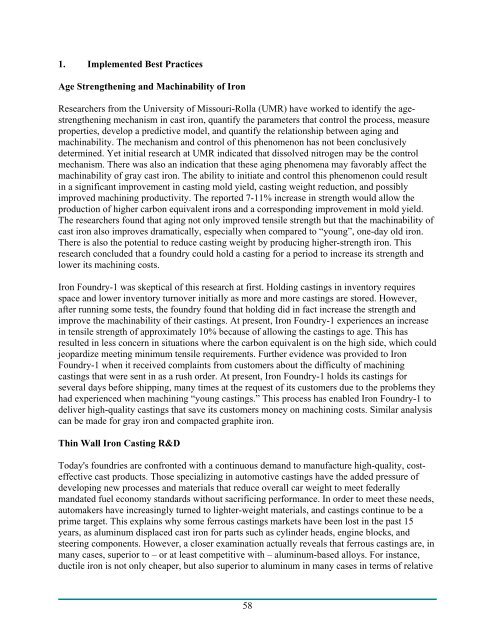Implementation of Metal Casting Best Practices - EERE - U.S. ...
Implementation of Metal Casting Best Practices - EERE - U.S. ...
Implementation of Metal Casting Best Practices - EERE - U.S. ...
You also want an ePaper? Increase the reach of your titles
YUMPU automatically turns print PDFs into web optimized ePapers that Google loves.
1. Implemented <strong>Best</strong> <strong>Practices</strong><br />
Age Strengthening and Machinability <strong>of</strong> Iron<br />
Researchers from the University <strong>of</strong> Missouri-Rolla (UMR) have worked to identify the agestrengthening<br />
mechanism in cast iron, quantify the parameters that control the process, measure<br />
properties, develop a predictive model, and quantify the relationship between aging and<br />
machinability. The mechanism and control <strong>of</strong> this phenomenon has not been conclusively<br />
determined. Yet initial research at UMR indicated that dissolved nitrogen may be the control<br />
mechanism. There was also an indication that these aging phenomena may favorably affect the<br />
machinability <strong>of</strong> gray cast iron. The ability to initiate and control this phenomenon could result<br />
in a significant improvement in casting mold yield, casting weight reduction, and possibly<br />
improved machining productivity. The reported 7-11% increase in strength would allow the<br />
production <strong>of</strong> higher carbon equivalent irons and a corresponding improvement in mold yield.<br />
The researchers found that aging not only improved tensile strength but that the machinability <strong>of</strong><br />
cast iron also improves dramatically, especially when compared to “young”, one-day old iron.<br />
There is also the potential to reduce casting weight by producing higher-strength iron. This<br />
research concluded that a foundry could hold a casting for a period to increase its strength and<br />
lower its machining costs.<br />
Iron Foundry-1 was skeptical <strong>of</strong> this research at first. Holding castings in inventory requires<br />
space and lower inventory turnover initially as more and more castings are stored. However,<br />
after running some tests, the foundry found that holding did in fact increase the strength and<br />
improve the machinability <strong>of</strong> their castings. At present, Iron Foundry-1 experiences an increase<br />
in tensile strength <strong>of</strong> approximately 10% because <strong>of</strong> allowing the castings to age. This has<br />
resulted in less concern in situations where the carbon equivalent is on the high side, which could<br />
jeopardize meeting minimum tensile requirements. Further evidence was provided to Iron<br />
Foundry-1 when it received complaints from customers about the difficulty <strong>of</strong> machining<br />
castings that were sent in as a rush order. At present, Iron Foundry-1 holds its castings for<br />
several days before shipping, many times at the request <strong>of</strong> its customers due to the problems they<br />
had experienced when machining “young castings.” This process has enabled Iron Foundry-1 to<br />
deliver high-quality castings that save its customers money on machining costs. Similar analysis<br />
can be made for gray iron and compacted graphite iron.<br />
Thin Wall Iron <strong>Casting</strong> R&D<br />
Today's foundries are confronted with a continuous demand to manufacture high-quality, cost-<br />
effective cast products. Those specializing in automotive castings have the added pressure <strong>of</strong><br />
developing new processes and materials that reduce overall car weight to meet federally<br />
mandated fuel economy standards without sacrificing performance. In order to meet these needs,<br />
automakers have increasingly turned to lighter-weight materials, and castings continue to be a<br />
prime target. This explains why some ferrous castings markets have been lost in the past 15<br />
years, as aluminum displaced cast iron for parts such as cylinder heads, engine blocks, and<br />
steering components. However, a closer examination actually reveals that ferrous castings are, in<br />
many cases, superior to – or at least competitive with – aluminum-based alloys. For instance,<br />
ductile iron is not only cheaper, but also superior to aluminum in many cases in terms <strong>of</strong> relative<br />
58

















